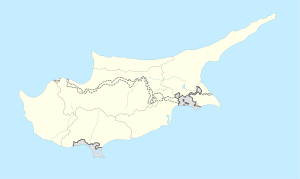Polis, Cyprus
| Polis Chrysochous | ||
|---|---|---|
 |
||
|
||
| Location in Cyprus | ||
| Coordinates: 35°2′0″N 32°26′0″E / 35.03333°N 32.43333°ECoordinates: 35°2′0″N 32°26′0″E / 35.03333°N 32.43333°E | ||
| Country |
|
|
| District | Paphos District | |
| Government | ||
| • Mayor | Angelos Georgiou | |
| Population (2011) | ||
| • Total | 3,690 | |
| Time zone | EET (UTC+2) | |
| • Summer (DST) | EEST (UTC+3) | |
Polis (or Polis Chrysochous; Greek: Πόλη Χρυσοχούς or Πόλις Χρυσοχούς; Turkish: Poli) is a small town at the north-west end of the island of Cyprus, at the centre of Chrysochous Bay, and on the edge of the Akamas peninsula nature reserve. It is a quiet tourist resort, the inhabitants' income being supplemented by agriculture and fishing. Polis is served by the fishing port of Latchi—a pole of attraction all the year round and reputed for its fish taverns, sea-sport facilities and boat rides up to Akamas—a must for all Polis visitors. However, the great advantage of Polis is its close vicinity to the utmost beautiful Akamas peninsula, a nature reserve area, destined to become a National Park, with its renowned Baths of Aphrodite. Α walk along its nature trails accompanied by the panoramic view of the bay of Polis is a popular experience with both locals and tourists.
On present evidence, Marion (the original name of Polis) was already inhabited at the end of the Neolithic and through the Chalcolithic period. It began to prosper from the Cypro-Archaic period onwards and became one of the most important ancient Cypriot city—kingdoms in the Cypro-Classical period with important commercial relations with the East Aegean islands, Attica and Corinth. In 312 BC, it was conquered by Ptolemy I and the kingdom was abolished until its reconquest by Ptolemy II Philadelphus who renamed the city after his sister and wife. The new city was smaller than Marion but it also flourished due to its close proximity to the copper mines. The city of Arsinoe continued to exist in the Roman, Early Christian and Early Byzantine periods when it seems to have suffered extensive destruction during the period of the Muslim conquests of the 7th century. Archaeological evidence indicates that the city was also inhabited during the late Medieval period between the 12th and 14th centuries.
...
Wikipedia


